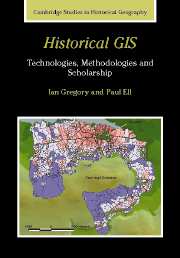Book contents
- Frontmatter
- Contents
- List of figures
- List of tables
- Acknowledgements
- 1 GIS and its role in historical research: an introduction
- 2 GIS: a framework for representing the Earth's surface
- 3 Building historical GIS databases
- 4 Basic approaches to handling data in a historical GIS
- 5 Using GIS to visualise historical data
- 6 Time in historical GIS databases
- 7 Geographic Information Retrieval: historical geographic information on the internet and in digital libraries
- 8 GIS and quantitative spatial analysis
- 9 From techniques to knowledge: historical GIS in practice
- References
- Index
4 - Basic approaches to handling data in a historical GIS
Published online by Cambridge University Press: 23 June 2009
- Frontmatter
- Contents
- List of figures
- List of tables
- Acknowledgements
- 1 GIS and its role in historical research: an introduction
- 2 GIS: a framework for representing the Earth's surface
- 3 Building historical GIS databases
- 4 Basic approaches to handling data in a historical GIS
- 5 Using GIS to visualise historical data
- 6 Time in historical GIS databases
- 7 Geographic Information Retrieval: historical geographic information on the internet and in digital libraries
- 8 GIS and quantitative spatial analysis
- 9 From techniques to knowledge: historical GIS in practice
- References
- Index
Summary
4.1 INTRODUCTION
Chapter 2 described how GIS represents the Earth's surface using vector and raster models that contain a combination of spatial and attribute data. This chapter explores the basic tools that GIS offers to exploit the data held within a historical GIS, and the limitations of them. In many ways, these tools are surprisingly limited; the one thing they have in common is that they provide ways of handling data in a manner that explicitly exploits the spatial characteristics of the data. This is why GIS is an effective instrument for geographical scholarship. The tools described here form the basic building blocks of the more advanced functionality and methodologies described in subsequent chapters.
GIS software provides three basic sets of tools. The first tool is querying the database using spatial, attribute or topological information. This allows data to be retrieved from the database using either the spatial or attribute data to allow geographical questions to be answered. The second tool is manipulating the spatial component of the data to allow new data to be created. This can involve converting a polygon layer to points defined by the centroid of the polygon or converting points to polygons using Thiessen polygons. Polygons can also be aggregated together based on the values of their attributes – a process known as dissolving. The third tool allows data to be integrated using their location, either informally by displaying two or more layers on the same map, or formally using a geometric intersection.
Information
- Type
- Chapter
- Information
- Historical GISTechnologies, Methodologies, and Scholarship, pp. 63 - 88Publisher: Cambridge University PressPrint publication year: 2007
